Click on images to enlarge

infestation (Photo: Sheldon Navie)

habit in flower (Photo: Sheldon Navie)

habit in fruit (Photo: Sheldon Navie)

older stems with spines (Photo: Sheldon Navie)

young stem and paired leaves (Photo: Sheldon Navie)
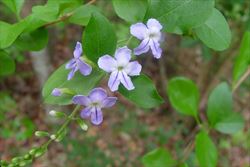
close-up of flowers (Photo: Sheldon Navie)

immature fruit (Photo: Sheldon Navie)
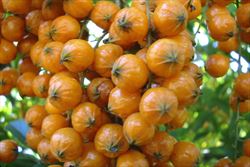
close-up of mature fruit (Photo: Sheldon Navie)

Duranta erecta 'Alba' (Photo: Sheldon Navie)
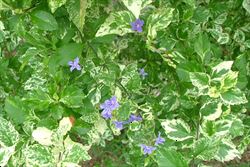
Duranta erecta 'Variegata' (Photo: Sheldon Navie)
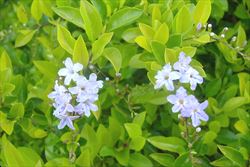
Duranta erecta 'Sheena's Gold' (Photo: Sheldon Navie)
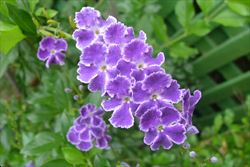
Duranta erecta 'Geisha Girl' (Photo: Sheldon Navie)

Duranta erecta 'Gold Edge' (Photo: Sheldon Navie)
Scientific Name
Duranta erecta L.
Synonyms
Duranta repens L.
Family
Verbenaceae
Common Names
Brazilian sky flower, Brazilian skyflower, duranta, forget me not bush, forget me not tree, golden dew drop, golden dewdrop, golden dewdrop duranta, golden dewdrops, golden tears, pigeon berry, pigeon-berry, pigeonberry, sky flower, sky-flower, skyflower
Origin
Native to southern USA (i.e. Texas and southern Florida), Mexico, Central America (i.e. Belize, Costa Rica, El Salvador, Guatemala, Honduras, Nicaragua and Panama), the Caribbean and South America (i.e. Surinam, Venezuela, Brazil, Bolivia, Colombia, Ecuador, Peru, Argentina and Paraguay).
Cultivation
A widely cultivated garden and hedge plant throughout the wetter and sub-humid regions of Australia. Several newer cultivars, which are thought to be less invasive, are still very popular in cultivation (e.g. Duranta erecta 'Sheena's Gold', Duranta erecta 'Geisha Girl', Duranta erecta 'Alba' and Duranta erecta 'Variegata').
Naturalised Distribution
Widely naturalised in the coastal districts of eastern Australia (i.e. in the coastal districts of south-eastern, central and northern Queensland and in the coastal districts of northern New South Wales). Also naturalised on Norfolk Island and possibly naturalised in the Northern Territory.
Naturalised overseas in southern USA (i.e. California, Arizona, Texas, Louisiana and Florida), Papua New Guinea, the Philippines, India, China, and on several Pacific islands (i.e. Fiji, French Polynesia, Tonga and Hawaii).
Habitat
A weed of disturbed sites, waste areas, roadsides, wetter pastures, open woodlands and densely forested areas, and particularly along waterways in sub-tropical and tropical regions.
Habit
A upright (i.e. erect) shrub or small tree usually growing 4-6 m tall, but occasionally reaching up to 7 m in height.
Distinguishing Features
- a slightly spiny upright shrub with drooping branches.
- its oppositely arranged leaves are sometimes toothed towards their tips.
- its blue or light purple (occasionally white) tubular flowers are borne in elongated clusters.
- it is most easily distinguished by its large clusters of yellow-orange mature fruit.
Stems and Leaves
The branches can are often drooping in nature, especially when carrying large numbers of mature fruit. There are usually at least some pairs of spines along the stems, one located at the base of each of the leaf stalks (i.e. they are axillary spines). Younger stems are green in colour and sparsely covered in close-lying (i.e. appressed) hairs.
The leaves are simple and paired (i.e. oppositely arranged) or occasionally borne in whorls of three. They have short leaf stalks (i.e. petioles) up to 1 cm long and are oval (i.e. elliptic) to egg-shaped in outline (i.e. ovate). The leaf blades (15-90 mm long and 12-60 mm wide) usually have entire margins, but sometimes they are slightly toothed (i.e. serrated) towards the pointed or rounded tips (i.e. acute or obtuse apices). These leaves are sometimes sparsely covered in close-lying (i.e. appressed) hairs when they are young, but they quickly becomes hairless (i.e. glabrous).
Flowers and Fruit
The blue or pale purple flowers (occasionally white) are borne in elongated clusters (5-30 cm long) at the tips of the branches and in the upper leaf stalks (i.e. in terminal and axillary racemes). These flowers (9-18 mm long) are borne on short stalks (i.e. they are sub-sessile) and each flower consists of a thin tube (about 1 cm long), made up of the fused petals, which opens into five distinct lobes (i.e. corolla lobes). The two lower petal lobes are slightly smaller and both of these has a darker stripe down its centre. Each flower also has five small green sepals (3-7 mm long), that are also fused together at the base, and four stamens. Flowering mostly occurs during summer and autumn.
The fruit are rounded (i.e. globose) 'berries' (i.e. drupes) and are usually borne in large clusters. These glossy fruit (5-14 mm across) turn from green to orange or yellow in colour as they mature.
Reproduction and Dispersal
This species reproduces mainly by seed, which are most commonly dispersed by birds that eat the brightly coloured fruit. also spread in dumped garden waste.
Environmental Impact
Duranta (Duranta erecta) is regarded as an environmental weed in Queensland and northern New South Wales. It was recently listed among the top 50 most invasive species in the New South Wales North Coast environmental weed survey and among the top 100 most invasive plants in south-eastern Queensland. It is also regarded as a "sleeper weed" in other parts of Australia and is listed as an undesirable plant in the Wet Tropics World Heritage Area in northern Queensland.
This species invades moist or wet sites in native bushland areas, and is particularly common along river banks and in riparian zones. An infestation was recently reported to be climbing 10 m up into the existing canopy of an at risk regional ecosystem near Townsville in northern Queensland.
Duranta (Duranta erecta) is also listed as an important invasive plant in China, where it causes obvious changes in natural ecosystems, and it is on the list of the most invasive horticultural plants in Hawaii.
Other Impacts
The leaves and 'berries' (i.e. drupes) are poisonous to people and animals, and are reported to have caused numerous deaths in domestic pets. Dense thickets can restrict access and reduce the productivity of pastures.
Legislation
Not declared or considered noxious by any state government authorities.

